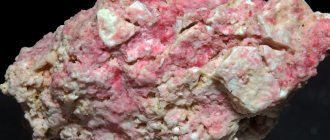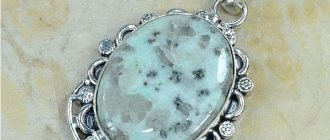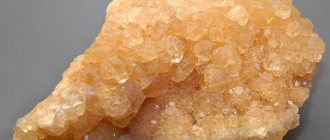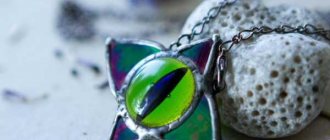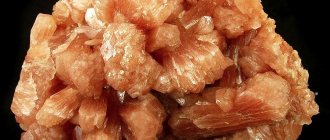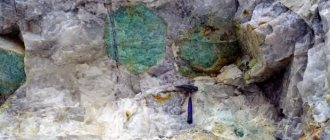Apatite contains the same elements as human bones. It is found in both living and inanimate nature. A large proportion of the world's phosphorus is bound in compounds of this mineral. Because of its ability to change properties and look like others, apatite is recognized as a mystical stone, around which many mysterious stories have developed. The stone is credited with magical properties and the ability to influence health.
PROPERTIES
The color of jewelry apatite is varied: yellow-green (asparagus stone), blue, blue-green (moroxite), blue, bluish-green, violet, yellow, green, brown, colorless. The color of apatite is associated with numerous impurity elements that make up the mineral. In blue manganapatites, the color is determined by pentavalent manganese, which forms tetrahedral complexes. The pink color of apatite, which disappears when heated to a temperature of 600°C and is restored upon irradiation, is associated with ions.
Cleavage is not obvious in the basal direction; the line is light, but with different shades according to the color of individual varieties (for example, those containing carbonaceous substances have a black line). When heated, it becomes phosphorescent, and before the blowpipe it is difficult to melt only at the edges.
Chemical composition
Several minerals from the phosphate class are called apatite. The formula of the compound forming the mineral is Ca10(PO4)6(OH, Cl, F)2. The most famous are three types: hydroxo-, chlorine- and fluorapatite. Depending on this, the above formula will change. The content of calcium oxides (CaO) and phosphorus is about 53-56% and 41%, respectively. The remaining insignificant proportion is fluorine, chlorine, sometimes carbonate, as well as various impurities.
In its pure form, apatite has no color. Impurities give various pale shades to the mineral. For example, manganese in various combinations colors crystals pink, purple, greenish-yellow, neodymium and iron give yellow and smoky tones.
MORPHOLOGY
It occurs in the form of prismatic and needle-shaped crystals, less often the crystals have a short-columnar or tabular habit. Large accumulations in the form of continuous sugar-like granular masses are common. Also radiate, grape-shaped aggregates and nodules; earthy accumulations; nodules. Forms pseudomorphs from organic residues; columnar varieties of apatite - “asparagus stone”, chalcedony-like spherulite crusts - “staffelite”. Rarely, individual prismatic crystals are found. Opaque crystals can reach enormous sizes. For example, apatite crystals weighing more than 200 kg were discovered in Canada. with a prism length of about 2 m. Much less common are small transparent crystals that can be used as jewelry raw materials.
Place of Birth
Apatites are minerals whose deposits on an industrial scale are quite rare. The largest deposit is located on the Kola Peninsula and is called “Khibinskoe”. Apatite ores, which consist mainly of fluorapatites and nepheline, are mined in this area. In addition, there are deposits in Yakutia (Seligdarskoye), Buryatia (Beloziminskoye, Oshurkovskoye), in the Urals (Ilmen Mountains), and the Baikal region.
Apatite sedimentary rock (phosphorite) accounts for more than 90% of the world's total phosphate ore reserves. Their deposits are known in North Africa: Algeria, Egypt, Tunisia, Western Sahara, Morocco.
Crystals suitable for jewelry production are mined in Finland, India, Germany, Norway, Czech Republic, USA, Myanmar and Brazil. The last two countries are famous for their beautiful varieties of the mineral with the cat's eye effect.
ORIGIN
Apatite is one of the most common accessory minerals. In igneous rocks it can be one of the first to begin to crystallize, and continue until crystallization is complete, often already at the intercumulus stage. Druses of crystals are often found in miaroles in granite pegmatites, and in sedimentary rocks - in the form of rounded grains. A characteristic mineral of carbonatites and lamprophyres. In these rocks it can be a xenocrystal, and come from both the mantle and crustal rocks, or crystallize directly from the melt. Apatite is one of the most common biominerals. Its microcrystals are found in the teeth and bones of vertebrates and humans. It is found in all forms of life - bacteria, invertebrates and plants. The main difference between biological apatite and crustal apatite is their chemical composition.
Astrological meaning of the stone
In the esoteric environment, apatite is credited with the properties of positive and negative effects on the human body. It is believed to be able to impart calmness, having a beneficial effect on the nervous system, if worn regularly on the body.
Astrologers recommend wearing this stone to people with a hysterical or hot-tempered character. The stone absorbs excess energy, bringing the body to a harmonious state. This property has a downside. It can have a negative impact on a calm person, suppressing vitality and causing drowsiness.
If a person believes in the influence of stones on well-being, then an apatite necklace can be worn to stabilize one’s emotional state. Astrologers especially recommend this stone for the Leo sign.
Thus, apatite has found application in many fields of activity: from fertilizers in agriculture to prosthetics in medicine. This makes it indispensable in the modern economy. It is credited with unique properties, which is why some people like to wear jewelry made from it. At the same time, you must always remember about its fragility; this stone requires careful handling and careful storage.
APPLICATION
Apatite is a raw material for the production of phosphate fertilizers, phosphorus and phosphoric acid; it is used in ferrous and non-ferrous metallurgy, in the production of ceramics and glass. Apatite is occasionally used by jewelers, but its widespread use in jewelry is impossible due to the low hardness of this stone and the fact that apatite is very fragile. Jewelry apatites are small in size - usually up to 5 carats, occasionally up to 20 carats, but they are of almost exclusively collector's interest. The largest gem-quality apatite crystal was found in Kenya and weighed 147 carats.
Apatite – Ca5(PO4)3(F,Cl,OH)
| Molecular weight | 509.12 g/mol |
| origin of name | from Greek arate – deception, misrepresentation, because apatite was often mistaken for other minerals |
| IMA status | not confirmed, since apatite is the name of a group of minerals |
Rules for handling products
Stones are fragile in structure and can easily break off upon impact, so they require careful handling. As already mentioned, apatite is less durable than other popular types of stones and can easily be accidentally scratched on any hard surface. There are other threats to the stone:
- Apatite sharply loses strength when exposed to ultrasound.
- If cleaning chemicals come into contact with the stone, it is necessary to rinse the stone as soon as possible and wipe thoroughly. Acids can permanently damage the appearance of stones.
- It is better to remove the jewelry during physical activity, because the material does not like sweating. Drops of sweat that fall on the product will change the properties of the stone, and it will fade over time.
If you wear apatite jewelry in everyday life, it will quickly ruin the appearance. Apatite belongs to the group of jewelry that should be protected from the external environment and not worn every day. It is recommended to store the product in a box.
Storage also has an important rule: apatite should not come into contact with metals and other stones, so in the box it must be wrapped separately in soft cloth.
Because there are so many requirements and restrictions, the stone is considered impractical and has never gained popularity among jewelry lovers.
PHYSICAL PROPERTIES
| Mineral color | white, green, yellow, red, blue |
| Stroke color | white |
| Transparency | transparent to translucent |
| Shine | glassy to greasy |
| Cleavage | imperfect by (0001) and (1011) |
| Hardness (Mohs scale) | 5 |
| Kink | uneven, conchoidal |
| Strength | fragile |
| Density (measured) | 3.16 – 3.22 g/cm3 |
| Radioactivity (GRapi) | 0 |
History of the name apatite
Apatite has a Greek name, which means “deception.”
Indeed, this semi-precious stone can easily be confused with tourmaline, topaz, beryl, amethyst, diopside or aquamarine. Advertising - Continued below
Apatites are a group of phosphate minerals. The green-yellow stone is called asparagus stone in Spain. In Norway, sea-green apatites are found, and for this reason the stone is nicknamed moroxite.
Apatite. Photo: carionmineraux.com
How to distinguish real fluorite from a fake?
Its unique properties and, above all, fluorescence will help you distinguish natural fluorite from a fake. The heated natural stone will definitely glow in the dark. Natural fluorite is also distinguished by photoluminescence. When exposed to ultraviolet light, the stone fluoresces strongly violet.
Interesting materials:
After how many days is sick leave transferred? After how many days is sick leave paid? How long does it take to pay sick leave? How long does it take to transfer sick leave? How long does it take for the Social Insurance Fund to transfer maternity benefits? After how many years is sick leave paid at 100? After how many years is 100 sick leave paid? How long does it take for bonuses to be awarded at Sportsmaster? How long will it take for sick leave to be paid after delivery? How long does it take to pay sick leave?
Type of mineral
The color palette of crystals is varied. The iridescent color is affected by various impurities, consisting of:
- from trace elements;
- macroelements;
- non-metallic compounds;
- heavy metals.
They play a fundamental role in the color transformation of the crystal:
- Incredibly beautiful jewelry made of transparent pink and light purple gems.
- Minerals of blue and green colors are considered to be common and traditional.
Many gems of unconventional color have their own names:
- Minerals reminiscent of cat's eye.
- Blue colored samples are called moroxites.
- Lemon - asparagus.
Name and zodiac sign: who suits it?
In astrology, this stone is universal because it brings favorable energy to all signs except Pisces. For these people, wearing a stone does not give anything good, but, on the contrary, apathy and lack of will will appear in their character. Representatives of the element of Fire, such as Aries, Leo, Sagittarius, are required to wear apatite. The stone acts differently for each zodiac sign: it will help Taurus recover from illnesses, and bring good luck to Virgos. The stone has a beneficial effect on their energy. It is also ideal for men named Egor and Alexey, bringing health and good luck.






